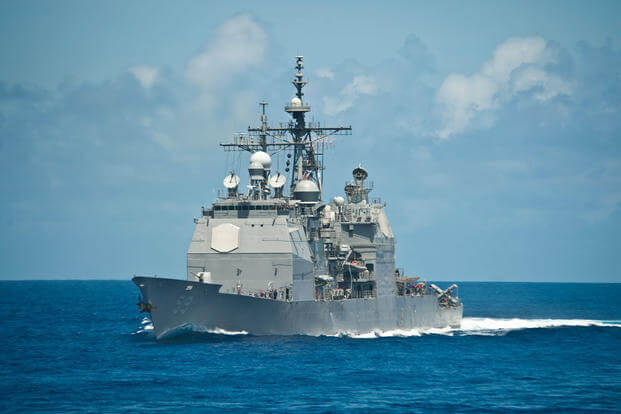House lawmakers are limiting the amount of time the Navy will be able to lay up portions of its fleet of cruisers from four years down to two years, citing combatant commanders' need for the ships' ballistic missile defense technologies.
The current Navy plan allows the service to take two cruisers out of the fleet rotation for modernization upgrades each year for up to four years. No more than six cruisers can be in modernization at any given time, according to the current provision.
Navy officials have described this plan to temporarily lay up portions of the cruiser fleet as a cost saving measure that will modernize the ships and extend their long-term service life. During the time that they are taken out of the operational fleet, the cruisers will save the Navy from paying operating costs and undergo a series of hull, mechanical and electrical upgrades. The ships will also receive combat systems modernization.
The House Armed Services Committee's Seapower and Projection Forces subcommittee proposed legislation that the modernization periods should be limited to two-years unless specifically extended by the Secretary of the Navy.
The most-recent Navy plan, called the "2-4-6" plan, schedules two cruisers at a time to be in service for up to four years. The new Congressional language is a "2-2-6" plan which places a two-year limit on the length of time a cruiser can be laid up for modernization work.
Rep. Randy Forbes, R-Va., chairman of the HASC Seapower and Projection Forces subcommittee, was the original author of the new provision shortening the time period for which cruisers could be removed from the fleet. The provision is based on combatant commanders' increased demand for ballistic missile defense capabilities because of North Korean, Russian and Chinese threats, subcommittee sources said.
"The Navy's original cruiser plan would have accomplished one thing, removing a significant portion of the Navy's ballistic missile defense capability from the fleet at the same time the demand for those capabilities is growing exponentially," Forbes said.
"The Armed Services Committee has crafted an alternative plan that modernizes a sufficient number of these critical assets in a timely manner and better positions our Navy to meet the demands of our Combatant Commanders going forward."
Forbes and other lawmakers do not want the critical capabilities provided by Navy cruisers to be removed from operational use for any longer than necessary at a time of rising international demand.
The Navy wanted to enter all 11 cruisers into a phased modernization period over ten years to retain warfare capability, extend the life of ships into the 2040s, and modernize the fleet, service officials said.
"Under the Navy's original PB-15 plan, the final CG (cruiser) retirement would have occurred in 2045, at a significantly reduced cost to the Navy," Chief of Naval Operations Adm. Jonathan Greenert said in written testimony to Congress last month.
Without a phased modernization plan, the Navy's fleet of cruisers would reach the end of their service life by 2030, Greenert has said.
In addition, Greenert authored an April 28 letter to HASC Chairman Mac Thornberry, R-Texas, making the case for the Navy's original plan and saying that a 2-4-6 plan is preferable to the 2-2-6 plan proposal.
"The Navy's original cruiser phased modernization plan would have saved approximately $4.5 billion cover the entire program (fiscal year 2015 – 2026). Under the current 2-4-6 plan mandated by Congress, those savings are $300-$400 million, primarily due to reduced manpower and operations savings. The proposed 2-2-6 language would eliminate all savings, as a two-year period does not support crew reduction," Greenert writes.
Greenert's letter adds that the proposed 2-2-6 plan will result in the retirement of Navy cruisers by 2035 and place substantial strain on the services' shipbuilding budget.
-- Kris Osborn can be reached at Kris.Osborn@military.com.
























